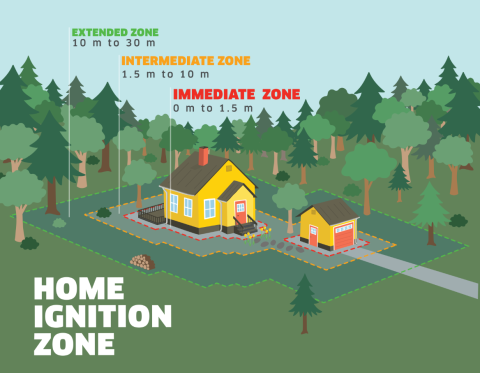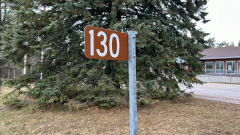
Be Fire Smart
- FireSmart Canada provides valuable resources on reducing the risk of fire by creating a safety zone around your home. Their Home Ignition Guide is a great tool to consider making changes to make your home less susceptible to fire risk.
- Immediate Zone (0m to 1.5m): Choose non-combustible building materials, clear vegetation and combustible material, and avoid planting woody shrubs or trees in this zone.
- Intermediate Zone (1.5m to 10m): Plant fire-resistant vegetation, avoid woody debris such as mulch, keep combustible items like firewood piles out of this zone.
- Extended Zone (10m to 30m): Trim trees and branches, clean up fallen branches, dry gas and needles to eliminate potential surface fuels for fires.
- Download a printable Home Ignition Guide
Dispose of your fire fuels responsibly
- Each spring, grass fires get out of control and cause needless damage to barns, homes, and cottages. It is important to dispose of these fire fuels responsibly.
- If you have grass, brush, or other wood debris, utilize the County of Simcoe's Leaf and Yard Waste pickups or use a backyard composter that is positioned away from your home/cottage and outbuildings like sheds.
Fireworks
- Have a plan for fireworks. If you are planning to have fireworks, remember that the Township of Tiny's Fireworks By-law only permits fireworks to be set off on Victoria Day, Canada Day, New Year's Eve, and New Year's Day between dusk and 11:00 p.m.
- Ensure you have adequate tools to handle the fireworks and any lingering embers such as metal tools like shovels, sand, and water. In an emergency, call 9-1-1.
Can we find you in an emergency?

- Ensure that your property address is clearly displayed from the road and can also be read at night. Every second counts in an emergency, and it is important that emergency services personnel can clearly find your address and your driveway.
- If your property address sign has been damaged, you can contact the Public Works Department to purchase a new sign by calling 705-526-4204.
Practice your escape plan
- Make an escape plan and practice escaping your home with the whole family. Teach all household members the technique of "stop, drop, roll" in case clothes catch on fire.
- Plan several escape routes away from your home by car and by foot.
- Maintain your smoke alarms and carbon monoxide alarms so that you are alerted to any concerns.



